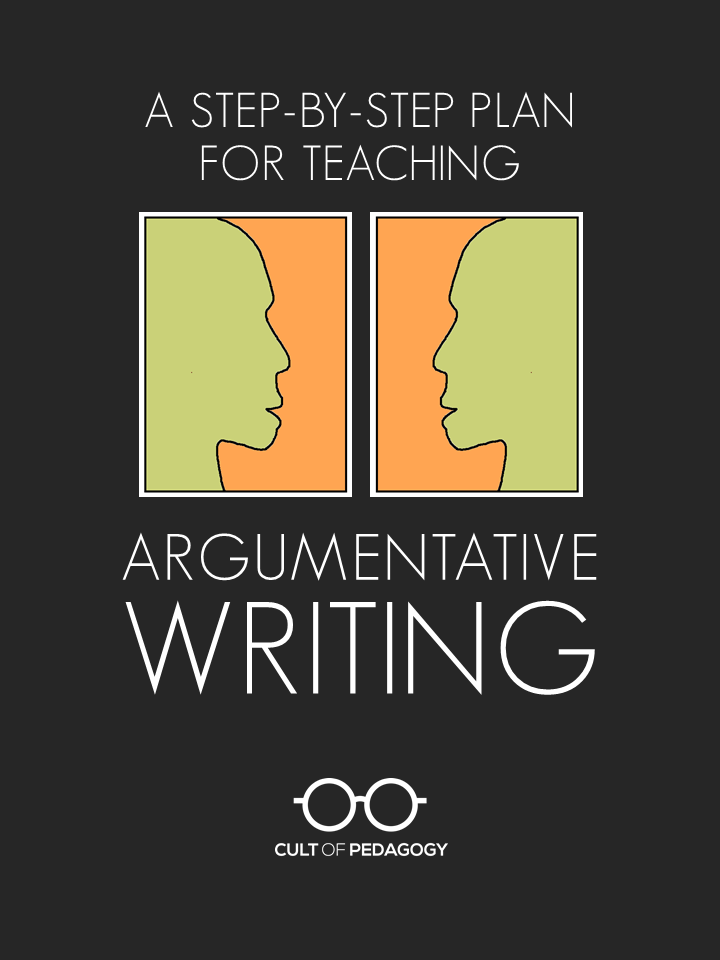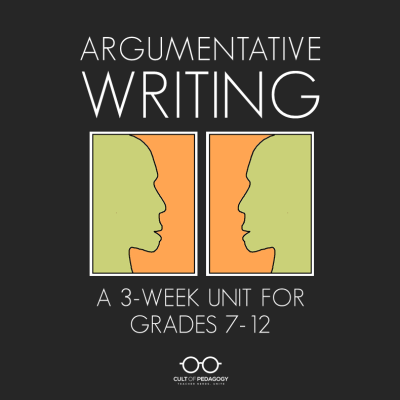
Listen to this post as a podcast:
This page contains Amazon Affiliate and Bookshop.org links. When you make a purchase through these links, Cult of Pedagogy gets a small percentage of the sale at no extra cost to you. What’s the difference between Amazon and Bookshop.org?
For seven years, I was a writing teacher. Yes, I was certified to teach the full spectrum of English language arts—literature, grammar and usage, speech, drama, and so on—but my absolute favorite, the thing I loved doing the most, was teaching students how to write.
Most of the material on this site is directed at all teachers. I look for and put together resources that would appeal to any teacher who teaches any subject. That practice will continue for as long as I keep this up. But over the next year or so, I plan to also share more of what I know about teaching students to write. Although I know many of the people who visit here are not strictly English language arts teachers, my hope is that these posts will provide tons of value to those who are, and to those who teach all subjects, including writing.
So let’s begin with argumentative writing, or persuasive writing, as many of us used to call it. This overview will be most helpful to those who are new to teaching writing, or teachers who have not gotten good results with the approach you have taken up to now. I don’t claim to have the definitive answer on how to do this, but the method I share here worked pretty well for me, and it might do the same for you. If you are an experienced English language arts teacher, you probably already have a system for teaching this skill that you like. Then again, I’m always interested in how other people do the things I can already do; maybe you’re curious like that, too.
Before I start, I should note that what I describe in this post is a fairly formulaic style of essay writing. It’s not exactly the 5-paragraph essay, but it definitely builds on that model. I strongly believe students should be shown how to move past those kinds of structures into a style of writing that’s more natural and fitting to the task and audience, but I also think they should start with something that’s pretty clearly organized.
So here’s how I teach argumentative essay writing.
Step 1: Watch How It’s Done
One of the most effective ways to improve student writing is to show them mentor texts, examples of excellent writing within the genre students are about to attempt themselves. Ideally, this writing would come from real publications and not be fabricated by me in order to embody the form I’m looking for. Although most experts on writing instruction employ some kind of mentor text study, the person I learned it from best was Katie Wood Ray in her book Study Driven (links to the book: Bookshop.org | Amazon).
Since I want the writing to be high quality and the subject matter to be high interest, I might choose pieces like Jessica Lahey’s Students Who Lose Recess Are the Ones Who Need it Most and David Bulley’s School Suspensions Don’t Work.
I would have students read these texts, compare them, and find places where the authors used evidence to back up their assertions. I would ask students which author they feel did the best job of influencing the reader, and what suggestions they would make to improve the writing. I would also ask them to notice things like stories, facts and statistics, and other things the authors use to develop their ideas. Later, as students work on their own pieces, I would likely return to these pieces to show students how to execute certain writing moves.
Step 2: Informal Argument, Freestyle
Although many students might need more practice in writing an effective argument, many of them are excellent at arguing in person. To help them make this connection, I would have them do some informal debate on easy, high-interest topics. An activity like This or That (one of the classroom icebreakers I talked about last year) would be perfect here: I read a statement like “Women have the same opportunities in life as men.” Students who agree with the statement move to one side of the room, and those who disagree move to the other side. Then they take turns explaining why they are standing in that position. This ultimately looks a little bit like a debate, as students from either side tend to defend their position to those on the other side.
Every class of students I have ever had, from middle school to college, has loved loved LOVED this activity. It’s so simple, it gets them out of their seats, and for a unit on argument, it’s an easy way to get them thinking about how the art of argument is something they practice all the time.
Step 3: Informal Argument, Not so Freestyle
Once students have argued without the support of any kind of research or text, I would set up a second debate; this time with more structure and more time to research ahead of time. I would pose a different question, supply students with a few articles that would provide ammunition for either side, then give them time to read the articles and find the evidence they need.
Next, we’d have a Philosophical Chairs debate (learn about this in my discussion strategies post), which is very similar to “This or That,” except students use textual evidence to back up their points, and there are a few more rules. Here they are still doing verbal argument, but the experience should make them more likely to appreciate the value of evidence when trying to persuade.
Before leaving this step, I would have students transfer their thoughts from the discussion they just had into something that looks like the opening paragraph of a written argument: A statement of their point of view, plus three reasons to support that point of view. This lays the groundwork for what’s to come.
Step 4: Introduction of the Performance Assessment
Next I would show students their major assignment, the performance assessment that they will work on for the next few weeks. What does this look like? It’s generally a written prompt that describes the task, plus the rubric I will use to score their final product.
Anytime I give students a major writing assignment, I let them see these documents very early on. In my experience, I’ve found that students appreciate having a clear picture of what’s expected of them when beginning a writing assignment. At this time, I also show them a model of a piece of writing that meets the requirements of the assignment. Unlike the mentor texts we read on day 1, this sample would be something teacher-created (or an excellent student model from a previous year) to fit the parameters of the assignment.
Step 5: Building the Base
Before letting students loose to start working on their essays, I make sure they have a solid plan for writing. I would devote at least one more class period to having students consider their topic for the essay, drafting a thesis statement, and planning the main points of their essay in a graphic organizer.
I would also begin writing my own essay on a different topic. This has been my number one strategy for teaching students how to become better writers. Using a document camera or overhead projector, I start from scratch, thinking out loud and scribbling down my thoughts as they come. When students see how messy the process can be, it becomes less intimidating for them. They begin to understand how to take the thoughts that are stirring around in your head and turn them into something that makes sense in writing.
For some students, this early stage might take a few more days, and that’s fine: I would rather spend more time getting it right at the pre-writing stage than have a student go off willy-nilly, draft a full essay, then realize they need to start over. Meanwhile, students who have their plans in order will be allowed to move on to the next step.
Step 6: Writer’s Workshop
The next seven to ten days would be spent in writer’s workshop, where I would start class with a mini-lesson about a particular aspect of craft. I would show them how to choose credible, relevant evidence, how to skillfully weave evidence into an argument, how to consider the needs of an audience, and how to correctly cite sources. Once each mini-lesson was done, I would then give students the rest of the period to work independently on their writing. During this time, I would move around the room, helping students solve problems and offering feedback on whatever part of the piece they are working on. I would encourage students to share their work with peers and give feedback at all stages of the writing process.
If I wanted to make the unit even more student-centered, I would provide the mini-lessons in written or video format and let students work through them at their own pace, without me teaching them. (To learn more about this approach, read this post on self-paced learning).
As students begin to complete their essays, the mini-lessons would focus more on matters of style and usage. I almost never bother talking about spelling, punctuation, grammar, or usage until students have a draft that’s pretty close to done. Only then do we start fixing the smaller mistakes.
Step 7: Final Assessment
Finally, the finished essays are handed in for a grade. At this point, I’m pretty familiar with each student’s writing and have given them verbal (and sometimes written) feedback throughout the unit; that’s why I make the writer’s workshop phase last so long. I don’t really want students handing in work until they are pretty sure they’ve met the requirements to the best of their ability. I also don’t necessarily see “final copies” as final; if a student hands in an essay that’s still really lacking in some key areas, I will arrange to have that student revise it and resubmit for a higher grade.
So that’s it. If you haven’t had a lot of success teaching students to write persuasively, and if the approach outlined here is different from what you’ve been doing, give it a try. And let’s keep talking: Use the comments section below to share your techniques or ask questions about the most effective ways to teach argumentative writing.
Want this unit ready-made?
If you’re a writing teacher in grades 7-12 and you’d like a classroom-ready unit like the one described above, including mini-lessons, sample essays, and a library of high-interest online articles to use for gathering evidence, take a look at my Argumentative Writing unit. Just click on the image below and you’ll be taken to a page where you can read more and see a detailed preview of what’s included.
Join my mailing list and get weekly tips, tools, and inspiration—in quick, bite-sized packages—all geared toward making your teaching more effective and fun. To thank you, I’ll send you a free copy of my e-booklet, 20 Ways to Cut Your Grading Time in Half, which has helped thousands of teachers spend less time grading!






This is useful information. In teaching persuasive speaking/writing I have found Monroe’s Motivated sequence very useful and productive. It is a classic model that immediately gives a solid structure for students.
Thanks for the recommendation, Bill. I will have to look into that!
Here’s a link to more information on Monroe’s Motivated sequence, for anyone who wants to learn more: https://www.mindtools.com/pages/article/MonroeMotivatedSequence.htm
What other sites do you recommend for teacher use on providing effective organizational structure in argumentative writing? As a K-12 Curriculum Director, I find that when teachers connect with and understand the organizational structure, they are more effective in their teaching/delivery.
Hey Jessica, in addition to the steps outlined here, you might want to check out Jenn’s post on graphic organizers. Graphic organizers are a great tool that you can use in any phase of a lesson. Using them as a prewrite can help students visualize the argument and organize their thoughts. There’s a link in that post to the Graphic Organizer Multi-Pack that Jenn has for sale on her Teachers Pay Teachers site, which includes two versions of a graphic organizer you can use specifically for argument organization. Otherwise, if there’s something else you had in mind, let us know and we can help you out. Thanks!
Dear Jennifer Gonzalez,
You are generous with your gift of lighting the path… I hardly ever write (never before) , but I must today… THANK YOU… THANK YOU….THANK YOU… mostly for reading your great teachings… So your valuable teachings will even be easy to benefit all the smart people facing challenge of having to deal with adhd…
I am not a teacher… but forever a student…someone who studied English as 2nd language, with a science degree & adhd…
You truly are making a difference in our World…
Thanks so much, Rita! I know Jenn will appreciate this — I’ll be sure to share with her!
Love it! Its simple and very fruitful
.
I can feel how dedicated you are! Thanks alot Jen
Great examples of resources that students would find interesting. I enjoyed reading your article. I’ve bookmarked it for future reference. Thanks!
You’re welcome, Sheryl!
Students need to be writing all the time about a broad range of topics, but I love the focus here on argumentative writing because if you choose the model writing texts correctly, you can really get the kids engaged in the process and in how they can use this writing in real-world situations!
I agree, Laura. I think an occasional tight focus on one genre can help them grow leaps and bounds in the skills specific to that type of writing. Later, in less structured situations, they can then call on those skills when that kind of thinking is required.
This is really helpful! I used it today and put the recess article in a Google Doc and had the kids identify anecdotal, statistic, and ‘other’ types of evidence by highlighting them in three different colors. It worked well! Tomorrow we’ll discuss which of the different types of evidence are most convincing and why.
Love that, Shanna! Thanks for sharing that extra layer.
Greetings Ms. Gonzales. I was wondering if you had any ideas to help students develop the cons/against side of their argument within their writing? Please advise. Thanks.
Hi Michael,
Considering audience and counterarguments are an important part of the argumentative writing process. In the Argumentative Writing unit Jenn includes specific mini-lessons that teach kids how, when and where to include opposing views in their writing. In the meantime, here’s a video that might also be helpful.
Hi,
Thank you very much for sharing your ideas. I want to share also the ideas in the article ‘Already Experts: Showing Students How Much They Know about Writing and Reading
Arguments’ by Angela Petit and Edna Soto…they explain a really nice activity to introduce argumentative writing. I have applied it many times and my students not only love it but also display a very clear pattern as the results in the activity are quite similar every time.
I hope you like it.
Lorena Perez
I’d like to thank you you for this excellence resource. It’s a wonderful addition to the informative content that Jennifer has shared.
What do you use for a prize?
I looked at the unit, and it looks and sounds great. The description says there are 4 topics. Can you tell me the topics before I purchase? We start argument in 5th grade, and I want to make sure the topics are different from those they’ve done the last 5 years before purchasing. Thanks!
Hi Carrie! If you go to the product page on TPT and open up the preview, you’ll see the four topics on the 4th page in more detail, but here they are: Social Networking in School (should social media sites be blocked in school?), Cell Phones in Class, Junk Food in School, and Single-Sex Education (i.e., genders separated). Does that help?
I teach 6th grade English in a single gendered (all-girls) class. We just finished an argument piece but I will definitely cycle back your ideas when we revisit argumentation. Thanks for the fabulous resources!
Glad to hear it, Madelyn!
I’m not a writing teacher and honestly haven’t been taught on how to teach writing. I’m a history teacher. I read this and found it helpful but have questions. First I noticed that amount of time dedicated to the task in terms of days. My questions are how long is a class period? I have my students for about 45 minutes. I also saw you mentioned in the part about self-paced learning that mini-lessons could be written or video format. I love these ideas. Any thoughts on how to do this with almost no technology in the room and low readers to non-readers? I’m trying to figure out how to balance teaching a content class while also teaching the common core skills. Thank you for any consideration to my questions.
Hey Jones,
To me, a class period is anywhere from 45 minutes to an hour; definitely varies from school to school.
As for the question about doing self-paced with very little tech? I think binders with written mini-lessons could work well, as well as a single computer station or tablet hooked up to a class set of videos. Obviously you’d need to be more diligent about rotating students in and out of these stations, but it’s an option at least. You might also give students access to the videos through computers in other locations at school (like the library) and give them passes to watch.
The thing about self-paced learning, as you may have seen in the self-paced post, is that if students need extra teacher support (as you might find with low readers or non-readers), they would spend more one-on-one time with the teacher, while the higher-level students would be permitted to move more quickly on their own. Does that help?
My primary goal for next semester is to increase academic discussion and make connections from discussion to writing, so I love how you launch this unit with lessons like Philosophical Chairs. I am curious, however, what is the benefit of the informal argument before the not-so-informal argument? My students often struggle to listen to one another, so I’m wondering if I should start with the more formal, structured version. Or, am I overthinking the management? Thanks so much for input.
Yikes! So sorry your question slipped through, and we’re just now getting to this, Sarah. The main advantage of having kids first engage in informal debate is that it helps them get into an argumentative mindset and begin to appreciate the value of using research to support their claims. If you’ve purchased the unit, you can read more about this in the Overview.
My 6th graders are progressing through their argumentative essay. I’m providing mini lessons along the way that target where most students are in their essay. Your suggestions will be used. I’ve chosen to keep most writing in class and was happy to read that you scheduled a lot of class time for the writing. Students need to feel comfortable knowing that writing is a craft and needs to evolve over time. I think more will get done in class and it is especially important for the struggling writers to have peers and the teacher around while they write. Something that I had students do that they liked was to have them sit in like-topic groups to create a shared document where they curated information that MIGHT be helpful along the way. By the end of the essay, all will use a fantastic add-on called GradeProof which helps to eliminate most of the basic and silly errors that 6th graders make.
Debbi! I LOVE the idea of a shared, curated collection of resources! That is absolutely fantastic! Are you using a Google Doc for this? Other curation tools you might consider are Padlet and Elink.
thanks v much for all this information
Love this! What do you take as grades in the meantime? Throughout this 2 week stretch?
Ideally, you wouldn’t need to take grades at all, waiting until the final paper is done to give one grade. If your school requires more frequent grades, you could assign small point values for getting the incremental steps done: So in Step 3 (when students have to write a paragraph stating their point of view) you could take points for that. During the writer’s workshop phase, you might give points for completion of a rough draft and participation points for peer review (ideally, they’d get some kind of feedback on the quality of feedback they give to one another). Another option would be to just give a small, holistic grade for each week based on the overall integrity of their work–are they staying on task? Making small improvements to their writing each day? Taking advantage of the resources? If students are working diligently through the process, that should be enough. But again, the assessment (grades) should really come from that final written product, and if everyone is doing what they’re supposed to be doing during the workshop phase, most students should have pretty good scores on that final product. Does that help?
Awesome Step 2! Teaching mostly teenagers in Northern Australia I find students’ verbal arguments are much more finely honed than their written work.
To assist with “building the base” I’ve always found sentence starters an essential entry point for struggling students. We have started using the ‘PEARL’ method for analytical and persuasive writing.
If it helps here a free scaffold for the method:
https://www.teacherspayteachers.com/Product/FREE-Paragraph-Scaffold-PEEL-to-PEARL-3370676
Thanks again,
Thank you for sharing this additional resource! It’s excellent!
I’ve been scouring the interwebs looking for some real advice on how I can help my struggling 9th grader write better. I can write. Since it comes naturally for me, I have a hard time breaking it down into such tiny steps that he can begin to feel less overwhelmed. I LOVE the pre-writing ideas here. My son is a fabulous arguer. I need to help him use those powers for the good of his writing skills. Do you have a suggestion on what I else I can be using for my homeschooled son? Or what you may have that could work well for home use?
Hi Melinda,
You might be interested in taking a look at Jenn’s Argumentative Writing unit which she mentions at the end of the post. Hope this helps!
Mam it would be good if you could post some steps of different writing and some samples as well so it can be useful for the students.
Hi Aalia! My name is Holly, and I work as a Customer Experience Manager for Cult of Pedagogy. It just so happens that in the near future, Jenn is going to release a narrative writing unit, so keep an eye out for that! As far as samples, the argumentative writing unit has example essays included, and I’m sure the narrative unit will as well. But, to find the examples, you have to purchase the unit from Teachers Pay Teachers.
I just want to say that this helped me tremendously in teaching argument to 8th Graders this past school year, which is a huge concept on their state testing in April. I felt like they were very prepared, and they really enjoyed the verbal part of it, too! I have already implemented these methods into my unit plan for argument for my 11th grade class this year. Thank you so much for posting all of these things! : )
-Josee` Vaughn
I’m so glad to hear it, Josee!!
Love your blog! It is one of the best ones.
I am petrified of writing. I am teaching grade 8 in September and would love some suggestions as I start planning for the year. Thanks!
This is genius! I can’t wait to get started tomorrow teaching argument. It’s always something that I have struggled with, and I’ve been teaching for 18 years. I have a class of 31 students, mostly boys, several with IEPs. The self-paced mini-lessons will help tremendously.
So glad you liked it, Britney!
My students will begin the journey into persuasion and argument next week and your post cemented much of my thinking around how to facilitate the journey towards effective, enthusiastic argumentative writing.
I use your rubrics often to outline task expectations for my students and the feedback from them is how useful breaking every task into steps can be as they are learning new concepts.
Additionally, we made the leap into blogging as a grade at https://mrsdsroadrunners.edublogs.org/2019/01/04/your-future/
It feels much like trying to learn to change a tire while the car is speeding down the highway. Reading your posts over the past years was a factor in embracing the authentic audience.
Thank You!
Trish
I love reading and listening to your always helpful tips, tricks, and advice! I was wondering if you had any thoughts on creative and engaging ways to have students share their persuasive writing?
My 6th students are just finishing up our persuasive writing where we read the book “Oh, Rats” by Albert Marrin and used the information gathered to craft a persuasive piece to either eliminate or protect rats and other than just reading their pieces to one another, I have been trying to think of more creative ways to share.
I thought about having a debate but (un)fortunately all my kids are so sweet and are on the same side of the argument – Protect the Rats!
Any ideas?
Hi Kiley!
Thanks for the positive feedback! So glad to hear that you are finding value in Cult of Pedagogy! Here are a few suggestions that you may be interested in trying with your students:
-A gallery walk: Students could do this virtually if their writing is stored online or hard copies of their writing. Here are some different ways that you could use gallery walks: Enliven Class Discussions With Gallery Walks
-Students could give each other feedback using a tech tool like Flipgrid. You could assign students to small groups or give them accountability partners. In Flipgrid, you could have students sharing back and forth about their writing and their opinions.
I hope this helps!
I love the idea of mentor texts for all of these reading and writing concepts. I saw a great one on Twitter with one text and it demonstrated 5-6 reasons to start a paragraph, all in two pages of a book! Is there a location that would have suggestions/lists of mentor texts for these areas? Paragraphs, sentences, voice, persuasive writing, expository writing, etc. It seems like we could share this info, save each other some work, and curate a great collection of mentor text for English Language Arts teachers. Maybe it already exists?
Hi Maureen,
Here are some great resources that you may find helpful:
Craft Lessons Second Edition: Teaching Writing K-8
Write Like This: Teaching Real-World Writing Through Modeling and Mentor Texts and
Mentor Texts, 2nd edition: Teaching Writing Through Children’s Literature, K-6
Thanks so much! I’ll definitely look into these.
I love the steps for planning an argumentative essay writing. When we return from Christmas break, we will begin starting a unit on argumentative writing. I will definitely use the steps. I especially love Step #2. As a 6th grade teacher, my students love to argue. This would set the stage of what argumentative essay involves. Thanks for sharing.
So glad to hear this, Gwen. Thanks for letting us know!
Great orientation, dear Jennifer. The step-by-step carefully planned pedagogical perspectives have surely added in the information repository of many.
Hi Jennifer,
I hope you are well. I apologise for the incorrect spelling in the previous post.
Thank you very much for introducing this effective instruction for teaching argumentative writing. I am the first year PhD student at Newcastle University, UK. My PhD research project aims to investigate teaching argumentative writing to Chinese university students. I am interested in the Argumentative Writing unit you have designed and would like to buy it. I would like to see the preview of this book before deciding to purchase it. I clicked on the image BUT the font of the preview is so small and cannot see the content clearly. I am wondering whether it could be possible for you to email me a detailed preview of what’s included. I would highly appreciate if you could help me with this.
Thank you very much in advance. Looking forward to your reply.
Take care and all the very best,
Chang
Hi Chang! Jenn’s Argumentative Writing Unit is actually a teaching unit geared toward grades 7-12 with lessons, activities, etc. If you click hereclick here to view the actual product, you can click on the green ‘View Preview’ button to see a pretty detailed preview of what’s offered. Once you open the preview, there is the option to zoom in so you can see what the actual pages of the unit are like. I hope this helps!
Great Content!
Another teacher showed me one of your posts, and now I’ve read a dozen of them.
With teaching students to argue, have you ever used the “What’s going on in this picture?”
https://www.nytimes.com/column/learning-whats-going-on-in-this-picture?module=inline
I used it last year and thought it was a non-threatening way to introduce learners to using evidence to be persuasive since there was no text.
Hi Denae,
I used to do something like this to help kids learn how to make inferences. Hadn’t thought of it from a persuasive standpoint. Interesting.
this is a very interesting topic, thanks!
Hi! I’m a teacher too! I was looking for inspiration and I found your article and thought you might find this online free tool interesting that helps make all students participate meaningfully and engage in a topic.
https://www.kialo-edu.com/
This tool is great for student collaboration and to teach argumentative writing in an innovative way. I hope this helps!